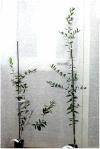Isolation and pathogenicity of Xylella fastidiosa associated to the olive quick decline syndrome in southern Italy
- PMID: 29255232
- PMCID: PMC5735170
- DOI: 10.1038/s41598-017-17957-z
Isolation and pathogenicity of Xylella fastidiosa associated to the olive quick decline syndrome in southern Italy
Abstract
In autumn 2013, the presence of Xylella fastidiosa, a xylem-limited Gram-negative bacterium, was detected in olive stands of an area of the Ionian coast of the Salento peninsula (Apulia, southern Italy), that were severely affected by a disease denoted olive quick decline syndrome (OQDS). Studies were carried out for determining the involvement of this bacterium in the genesis of OQDS and of the leaf scorching shown by a number of naturally infected plants other than olive. Isolation in axenic culture was attempted and assays were carried out for determining its pathogenicity to olive, oleander and myrtle-leaf milkwort. The bacterium was readily detected by quantitative polymerase chain reaction (qPCR) in all diseased olive trees sampled in different and geographically separated infection foci, and culturing of 51 isolates, each from a distinct OQDS focus, was accomplished. Needle-inoculation experiments under different environmental conditions proved that the Salentinian isolate De Donno belonging to the subspecies pauca is able to multiply and systemically invade artificially inoculated hosts, reproducing symptoms observed in the field. Bacterial colonization occurred in prick-inoculated olives of all tested cultivars. However, the severity of and timing of symptoms appearance differed with the cultivar, confirming their differential reaction.
Conflict of interest statement
The authors declare that they have no competing interests.
Figures







Similar articles
-
Xylella fastidiosa: an examination of a re-emerging plant pathogen.Mol Plant Pathol. 2018 Apr;19(4):786-800. doi: 10.1111/mpp.12585. Epub 2017 Oct 24. Mol Plant Pathol. 2018. PMID: 28742234 Free PMC article.
-
Xylella fastidiosa, a new plant pathogen that threatens global farming: Ecology, molecular biology, search for remedies.Biochem Biophys Res Commun. 2018 Jul 12;502(2):173-182. doi: 10.1016/j.bbrc.2018.05.073. Biochem Biophys Res Commun. 2018. PMID: 29887124
-
Xylella fastidiosa subsp. pauca and olive produced lipids moderate the switch adhesive versus non-adhesive state and viceversa.PLoS One. 2020 May 15;15(5):e0233013. doi: 10.1371/journal.pone.0233013. eCollection 2020. PLoS One. 2020. PMID: 32413086 Free PMC article.
-
Thidiazuron: New Trends and Future Perspectives to Fight Xylella fastidiosa in Olive Trees.Antibiotics (Basel). 2022 Jul 14;11(7):947. doi: 10.3390/antibiotics11070947. Antibiotics (Basel). 2022. PMID: 35884201 Free PMC article. Review.
-
Xylella fastidiosa subsp. pauca, Neofusicoccum spp. and the Decline of Olive Trees in Salento (Apulia, Italy): Comparison of Symptoms, Possible Interactions, Certainties and Doubts.Plants (Basel). 2023 Oct 17;12(20):3593. doi: 10.3390/plants12203593. Plants (Basel). 2023. PMID: 37896056 Free PMC article. Review.
Cited by
-
Prospects of advanced metagenomics and meta-omics in the investigation of phytomicrobiome to forecast beneficial and pathogenic response.Mol Biol Rep. 2022 Dec;49(12):12165-12179. doi: 10.1007/s11033-022-07936-7. Epub 2022 Sep 28. Mol Biol Rep. 2022. PMID: 36169892 Review.
-
Xylella fastidiosa in Europe: From the Introduction to the Current Status.Plant Pathol J. 2022 Dec;38(6):551-571. doi: 10.5423/PPJ.RW.09.2022.0127. Epub 2022 Dec 1. Plant Pathol J. 2022. PMID: 36503185 Free PMC article. Review.
-
Insights into the Methodological, Biotic and Abiotic Factors Influencing the Characterization of Xylem-Inhabiting Microbial Communities of Olive Trees.Plants (Basel). 2023 Feb 17;12(4):912. doi: 10.3390/plants12040912. Plants (Basel). 2023. PMID: 36840260 Free PMC article. Review.
-
Pseudogenes and host specialization in the emergent bacterial plant pathogen Xylella fastidiosa.Appl Environ Microbiol. 2025 May 21;91(5):e0207024. doi: 10.1128/aem.02070-24. Epub 2025 Apr 10. Appl Environ Microbiol. 2025. PMID: 40207969 Free PMC article.
-
Screening and identification of BP100 peptide conjugates active against Xylella fastidiosa using a viability-qPCR method.BMC Microbiol. 2020 Jul 29;20(1):229. doi: 10.1186/s12866-020-01915-3. BMC Microbiol. 2020. PMID: 32727358 Free PMC article.
References
-
- Martelli GP. The current status of the quick decline syndrome of olive in southern Italy. Phytoparasitica. 2016;44:1–10. doi: 10.1007/s12600-015-0498-6. - DOI
-
- Saponari M, Boscia D, Nigro F, Martelli GP. Identification of DNA sequences related to Xylella fastidiosa in oleander, almond and olive trees exhibiting leaf scorch symptoms in Apulia (southern Italy) J. Plant Pathol. 2013;95:668.
-
- Haelterman, R. M. et al. First presumed diagnosis of Xylella fastidiosa causing olive scorch in Argentina. J. Plant Pathol.97, 393 (2015).
Publication types
MeSH terms
LinkOut - more resources
Full Text Sources
Other Literature Sources

